Radio 60-1700 MHz on RTL2832 for 20 bucks or SDR for beginners
In this article I will talk about how, having spent very little money and a little time, get a radio that can receive anything in the range of 60-1700 MHz (radio stations, TV sound, radio amateurs, pocket radio stations and much more). For this
We use a DVB tuner on an RTL2832 chip, operating in a special mode, which can be purchased for $ 20 or even cheaper.
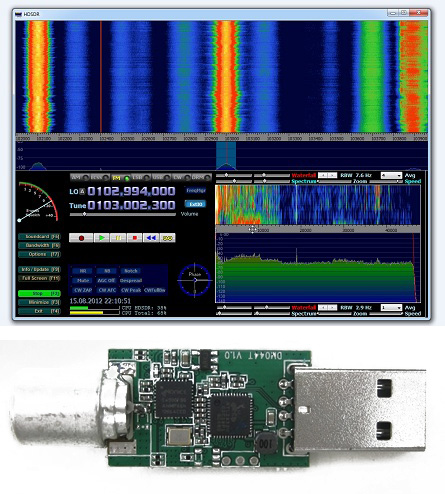
People use radio waves for a variety of purposes. Radio amateurs communicate with each other, the dispatching service gives instructions to the pilots of the aircraft, taxi drivers take orders, which they learn on the radio, the car alarm keypad talks to the car to confirm its authenticity and open the doors. Therefore, listening to the broadcast has always been interesting to many.
')
Previously, building a receiver capable of receiving a wide range of frequencies and decoding different types of signal modulations was a difficult task, so ready-made receivers were expensive, and not everyone was able to assemble it on their own. With the advent of productive processors, it became possible to replace a significant part of electronic components with software processing - fine tuning of the receiving frequency, demodulation, filtering of noise and interference - all this is perfectly implemented by software, and it also gets an opportunity for fine tuning without the need for rework.
The hardware remains only the task of pre-allocating the desired portion of the radio band and its digitization. This concept was called SDR - Software-defined Radio.
Read more about SDR in Wikipedia .
Now anyone can get acquainted with the SDR technology. We owe this to Realtek, which launched the RTL2832 chip. Its original purpose is a USB DVB-T decoder for receiving digital TV channels. The analog part (tuning to the frequency of the TV channel) is implemented by the Elonics E4000 solid-state tuner, for which the RTL2832 has outputs to control. Thus, based on these two chips and a small number of other parts, manufacturers can assemble USB DVB-T tuners.
A mode was detected in this chip, which disables all embedded decoding functions and puts it into the fast ADC mode, which digitizes everything that the E4000 gives out at a frequency of up to 3 million eight-bit samples per second. In turn, the E4000 can be tuned to a frequency of 60 to 1700 MHz, giving the selected “piece” of a 3 MHz wide radio band for digitization to the RTL2832 input. Adding to this the processing program on the PC, we get a completely working SDR receiver.
I will try to describe in simple words:
Without a TV tuner based on RTL2832, we can not do.
Here is a list of devices that suit us.
Easier and cheaper to buy a tuner on eBay. It is easy to find it - just use the name of the chips as a request . There is no particular difference between specific models of tuners, you can choose the cheapest one or in the case you like.
Consider setting up software for Windows.
Liked? Then the cultivation process is almost endless. There are a large number of much more sensitive and functional SDR set-top boxes. Some of them provide digitization and review bandwidth up to 100 MHz, some are able to work on the transmission, almost all more expensive consoles digitize the signal with a resolution of 16 or 24 bits instead of 8. Pay attention to the USRP project.
More sophisticated software tools allow you to decode digital radio stations, receive signals from a variety of wireless sensors, and even decode analog and digital television signals. Check out the PowerSDR and GnuRadio projects.
Upd: Table of SDR receivers with indication of opportunities and approximate prices.
We use a DVB tuner on an RTL2832 chip, operating in a special mode, which can be purchased for $ 20 or even cheaper.

Radio waves
People use radio waves for a variety of purposes. Radio amateurs communicate with each other, the dispatching service gives instructions to the pilots of the aircraft, taxi drivers take orders, which they learn on the radio, the car alarm keypad talks to the car to confirm its authenticity and open the doors. Therefore, listening to the broadcast has always been interesting to many.
')
Software-defined Radio
Previously, building a receiver capable of receiving a wide range of frequencies and decoding different types of signal modulations was a difficult task, so ready-made receivers were expensive, and not everyone was able to assemble it on their own. With the advent of productive processors, it became possible to replace a significant part of electronic components with software processing - fine tuning of the receiving frequency, demodulation, filtering of noise and interference - all this is perfectly implemented by software, and it also gets an opportunity for fine tuning without the need for rework.
The hardware remains only the task of pre-allocating the desired portion of the radio band and its digitization. This concept was called SDR - Software-defined Radio.
Read more about SDR in Wikipedia .
TV tuner RTL2832
Now anyone can get acquainted with the SDR technology. We owe this to Realtek, which launched the RTL2832 chip. Its original purpose is a USB DVB-T decoder for receiving digital TV channels. The analog part (tuning to the frequency of the TV channel) is implemented by the Elonics E4000 solid-state tuner, for which the RTL2832 has outputs to control. Thus, based on these two chips and a small number of other parts, manufacturers can assemble USB DVB-T tuners.
A mode was detected in this chip, which disables all embedded decoding functions and puts it into the fast ADC mode, which digitizes everything that the E4000 gives out at a frequency of up to 3 million eight-bit samples per second. In turn, the E4000 can be tuned to a frequency of 60 to 1700 MHz, giving the selected “piece” of a 3 MHz wide radio band for digitization to the RTL2832 input. Adding to this the processing program on the PC, we get a completely working SDR receiver.
How it all works
I will try to describe in simple words:
- An antenna connected to the tuner receives signals from the air.
- The E4000 chip allocates a portion of the radio band, starting where we indicated to it and 3 MHz wide, amplifies it.
- The RTL2832 chip digitizes this plot and transfers it via USB to a computer.
- The program (GnuRadio, HDSDR, or other) “tunes” to the selected frequency within the previously selected 3 MHz, performs demodulation in this way, and sends the resulting sound to the sound card. It can also send commands to the E4000 chip for rebuilding to another part of the range.
We buy a tuner
Without a TV tuner based on RTL2832, we can not do.
Here is a list of devices that suit us.
Easier and cheaper to buy a tuner on eBay. It is easy to find it - just use the name of the chips as a request . There is no particular difference between specific models of tuners, you can choose the cheapest one or in the case you like.
Install and configure
Consider setting up software for Windows.
- Download the installer that contains the driver for RTL2832, the plug-in for the HDSDR program and the HDSDR program itself. If the link dies, look for a new version from the author .
- When launching, when selecting components, we note that we need to download HDSDR.
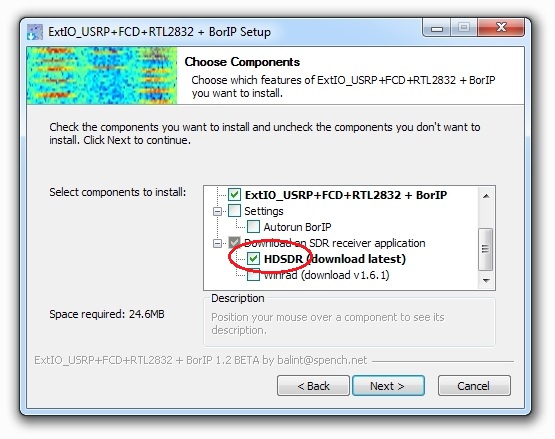
- Specify the desired path and remember it.
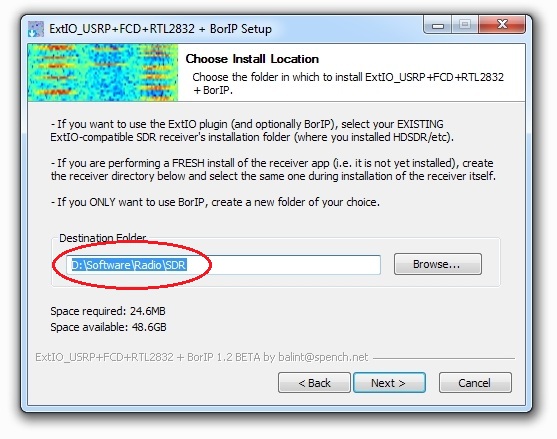
- The Zadig program starts to install the WinUSB driver. In the menu, select "List all devices".
- Our tuner will look something like this: “Bulk-In, interface 0” (for other cases read here ). We select the tuner, we select also "WinUSB", we click "Install".
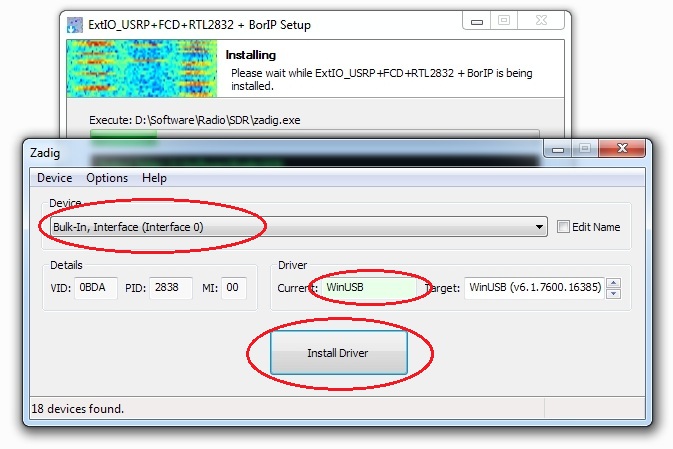
- The HDSDR setup program starts. Choose the same path that indicated earlier.
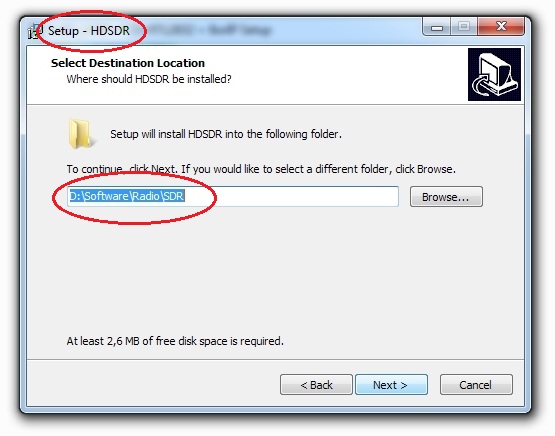
- Install, run. The main HDSDR window opens. Press the ExtIO button.

- The RTL2832 plugin window opens. We write the word "RTL" in the Device Hint field, in the Sample Rate field - "2", we click "Create".

- Click "Start" in the main window. Work has begun!
We see the panorama of the selected part of the range at the top.
Dragging the scale under the panorama or the “Tune” button - select another area.
Click on the panorama - the frequency of fine tuning.
Buttons below it - modulation type.
For better quality, click "Bandwidth" and select Output - "48000" or "96000".
The picture shows a VHF broadcasting section from 102 to 104 MHz and three radio stations on it, one of which we are tuned to.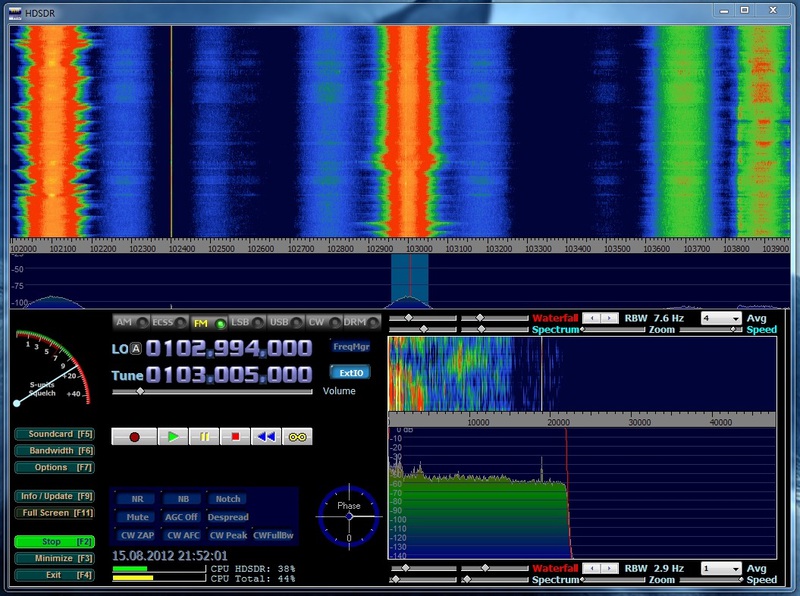
- Experimenting, listening to the broadcast. Sometimes it may be necessary to turn the tuner off and on again. It is also advisable to find an antenna more serious than the one that comes with it in the kit.
What's next?
Liked? Then the cultivation process is almost endless. There are a large number of much more sensitive and functional SDR set-top boxes. Some of them provide digitization and review bandwidth up to 100 MHz, some are able to work on the transmission, almost all more expensive consoles digitize the signal with a resolution of 16 or 24 bits instead of 8. Pay attention to the USRP project.
More sophisticated software tools allow you to decode digital radio stations, receive signals from a variety of wireless sensors, and even decode analog and digital television signals. Check out the PowerSDR and GnuRadio projects.
Upd: Table of SDR receivers with indication of opportunities and approximate prices.
Links
Source: https://habr.com/ru/post/149698/
All Articles